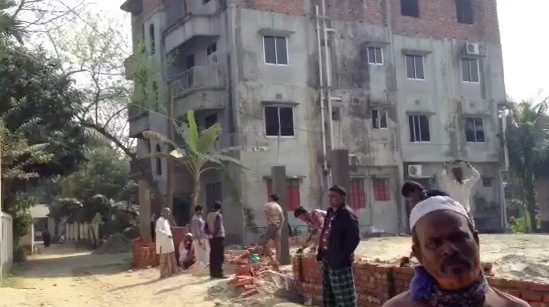Starting HEALS
The scientists were eager to get started even before the grant money was due to come through in April 2000. So in late 1999, they obtained $50,000 from the Mailman School and $100K from the Earth Institute. With this, in February 2000 van Geen and Ahsan flew to Bangladesh laden with 50 boxes of empty vials, a handheld GPS system, markers and tape to collect additional water samples.
Although the initial testing was concentrated in Sonargaon, a 25-square kilometer area in Araihazar emerged as the leading contender for the central research site. It had a fair number of contaminated wells and a population with symptoms of arsenicosis. It was also close to Dhaka with its international airport, which would make it easier to ship samples to the US.
Local partner . For any project in Bangladesh, the Columbia scientists needed a local partner. The public health researchers had originally planned to collaborate with Community Hospital in Dhaka. But the latter declined after failing to come to terms over logistics. So they turned instead to the National Institute of Preventive and Social Medicine (NIPSOM).

HEALS project site, Araihazar
Dr. Iftikhar Hussain was a prominent member of NIPSOM, and in charge of the Ministry of Health and Family Welfare arsenic program. Dr. Hussain agreed to be the local director of the Superfund project. He had strong personal and professional connections to Araihazar, which reinforced the wisdom of basing the project there.
In February 2000, the project hired Parvez fulltime as HEALS project director, based in New York. His job was to design the surveys for the project, handle logistics, and act as liaison and general troubleshooter. In June, he flew to Bangladesh for what proved a six-month stay. He hired members of a 16-person team, which started preparatory fieldwork. The team gathered additional water samples, charted well depths and assembled demographic and household information in preparation for the study proper, which they hoped to start in the fall. By October, the researchers had identified and tested roughly 6,000 tube wells in the Araihazar study area; only then did they start demographic and behavioral surveys. [15]
Delays . Parvez had meanwhile to deal with a number of bureaucratic delays. In April, the team submitted an application for ethical approval to the Bangladesh Medical Research Council (BMRC). The BMRC’s Central Ethics Review Committee monitored human experiments and was recognized as an institutional review board in the US. Approval finally came in July. The HEALS project celebrated its official launch days later.
In addition, the contract between Columbia and NIPSOM took months to finalize. In the fall, Graziano decided to make a personal visit to sort out the problems with the contract. Only in October was the final hurdle overcome and the contract signed.
[15] Ahsan et al, “Arsenic Exposure from Drinking Water and Risk of Premalignant Skin Lesions In Bangladesh: Baseline Results from the Health Effects of Arsenic Longitudinal Study,” American Journal of Epidemiology, Vol. 163, No. 12. See: http://aje.oxfordjournals.org/content/163/12/1138.full.pdf+html